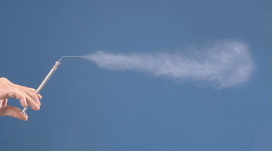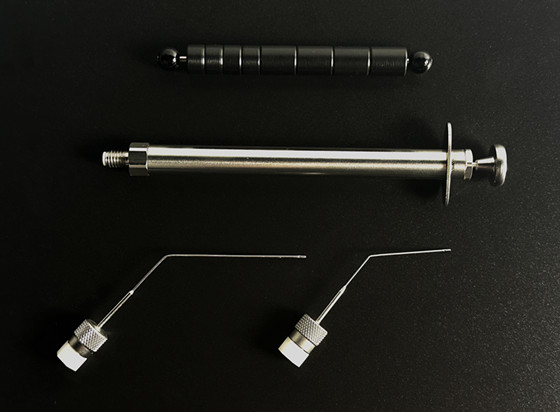Yuyan MicroSprayer Aerosolizer Video
https://www.bilibili.com/video/BV1XV411T7Ss/
The founders of Penn-Century retired and closed in 2015.
Penn-Century’s patented devices are no longer available for purchase from us or any other supplier.
Shanghai Yuyan Instruments Co.,Ltd. now provide a self-developed MicroSprayer® Aerosolizer and High Pressure Syringe – Model YAN30012 for fast, precise, targeted, liquid aerosol doses of up to 250µl in mouse, rat or larger animals or custom applications, whitch can be used for replace Penn-Century’s Model IA-1C and FMJ-250.
The MicroSprayer® Aerosolizer – Model YAN30012 High Pressure Syringe permits precise administration of a wide range of pharmaceutical, biologic, radiographic and toxicologic formulations in aerosol form directly to the lungs.
The MicroSprayer® Aerosolizer – Model YAN30012 High Pressure Syringe is designed for fast, targeted, air-free intratracheal aerosol administration to mouse or rat. The device can be used to administer a precisely quantifiable, highly-concentrated, air-free plume of liquid aerosol directly into the lungs or other locations. It may also be used for intranasal or in vitro applications. It can aerosolize a wide range of liquids or particle solutions/suspensions, including pharmaceutical and biologic formulations, contrast/imaging agents and toxicological materials. (It does not administer dry powders.)

For intrapulmonary applications, the tip of the device is gently inserted down the trachea of the anesthetized anima – near to, but not touching the carina (first bifurcation). The portion that is inserted into the trachea measures 1.25″/2″.
. Quick, precise aerosol dosing directly to the lungs – with no waste
. Purely mechanical, air-free technology
. Uses no heat, propellant, ultrasound or compressed air. No air burden to subject.
. Unique patented design is light, hand-held, easy to use
. Rounded tip permits safe, gentle intratracheal insertion
. Fully sterilizable, autoclavable and reusable
. Delivers a far higher volume and concentration than is possible with nebulizer/inhalation systems
. Produces a far broader, more uniform distribution than liquid bolus/droplet instillation methods
Intratracheal use of MicroSprayer® Aerosolizer:
For best results, position the tip of the device near to – but not touching the carina, or first bifurcation.
Accessories:
 |
 |
 |
| Intubation Platform |
Small Animal Laryngoscope |
Custom MicroSprayer®/Syringe Assembly |
Yuyan MicroSprayer Aerosolizer Publications
1. Li, Cheng et al. “Broad neutralization of SARS-CoV-2 variants by an inhalable bispecific single-domain antibody.” Cell vol. 185,8 (2022): 1389-1401.e18. doi:10.1016/j.cell.2022.03.009
2. Peng, Boya et al. “Robust delivery of RIG-I agonists using extracellular vesicles for anti-cancer immunotherapy.” Journal of extracellular vesicles vol. 11,4 (2022): e12187. doi:10.1002/jev2.12187
3. Yue, Dayong et al. “Diesel exhaust PM2.5 greatly deteriorates fibrosis process in pre-existing pulmonary fibrosis via ferroptosis.” Environment international vol. 171 (2023): 107706. doi:10.1016/j.envint.2022.107706
4. Zhang, Mengjun et al. “Airway epithelial cell-specific delivery of lipid nanoparticles loading siRNA for asthma treatment.” Journal of controlled release : official journal of the Controlled Release Society vol. 352 (2022): 422-437. doi:10.1016/j.jconrel.2022.10.020
5. Gu, Peiyu et al. “Protective function of interleukin-22 in pulmonary fibrosis.” Clinical and translational medicine vol. 11,8 (2021): e509. doi:10.1002/ctm2.509
6. Wu, Lan et al. “Poly(lactide-co-glycolide) Nanoparticles Mediate Sustained Gene Silencing and Improved Biocompatibility of siRNA Delivery Systems in Mouse Lungs after Pulmonary Administration.” ACS applied materials & interfaces vol. 13,3 (2021): 3722-3737. doi:10.1021/acsami.0c21259
7. Tian, Xidong et al. “Pulmonary Delivery of Reactive Oxygen Species/Glutathione-Responsive Paclitaxel Dimeric Nanoparticles Improved Therapeutic Indices against Metastatic Lung Cancer.” ACS applied materials & interfaces vol. 13,48 (2021): 56858-56872. doi:10.1021/acsami.1c16351
8. Yang, Huilin et al. “Triptolide dose-dependently improves LPS-induced alveolar hypercoagulation and fibrinolysis inhibition through NF-κB inactivation in ARDS mice.” Biomedicine & pharmacotherapy = Biomedecine & pharmacotherapie vol. 139 (2021): 111569. doi:10.1016/j.biopha.2021.111569
9. Su, Ruonan et al. “Venetoclax nanomedicine alleviates acute lung injury via increasing neutrophil apoptosis.” Biomaterials science vol. 9,13 (2021): 4746-4754. doi:10.1039/d1bm00481f
10. Xu, Yingying et al. “PEGylated pH-responsive peptide-mRNA nano self-assemblies enhance the pulmonary delivery efficiency and safety of aerosolized mRNA.” Drug delivery vol. 30,1 (2023): 2219870. doi:10.1080/10717544.2023.2219870
11. Wu, Yanqi et al. “SN50 attenuates alveolar hypercoagulation and fibrinolysis inhibition in acute respiratory distress syndrome mice through inhibiting NF-κB p65 translocation.” Respiratory research vol. 21,1 130. 27 May. 2020, doi:10.1186/s12931-020-01372-6
12. Chen, Huanjie et al. “Enhanced secretion of hepatocyte growth factor in human umbilical cord mesenchymal stem cells ameliorates pulmonary fibrosis induced by bleomycin in rats.” Frontiers in pharmacology vol. 13 1070736. 6 Jan. 2023, doi:10.3389/fphar.2022.1070736
13. Han, Meishan et al. “Engineering of Stimulus-Responsive Pirfenidone Liposomes for Pulmonary Delivery During Treatment of Idiopathic Pulmonary Fibrosis.” Frontiers in pharmacology vol. 13 882678. 25 Apr. 2022, doi:10.3389/fphar.2022.882678
14. Ba, Xin et al. “Simiao pill attenuates collagen-induced arthritis and bleomycin-induced pulmonary fibrosis in mice by suppressing the JAK2/STAT3 and TGF-β/Smad2/3 signalling pathway.” Journal of ethnopharmacology vol. 309 (2023): 116274. doi:10.1016/j.jep.2023.116274
15. Cai, Zimin, et al. "Enhanced protective activity of 1, 8-cineole on emphysema using hyaluronic acid-coated liposomes via quantitative pulmonary administration in mice." Journal of Drug Delivery Science and Technology 72 (2022): 103402. doi:10.1016/j.jddst.2022.103402
16. Wu, Lan, et al. "Quantitative comparison of three widely-used pulmonary administration methods in vivo with radiolabeled inhalable nanoparticles." European Journal of Pharmaceutics and Biopharmaceutics 152 (2020): 108-115. doi:10.1016/j.ejpb.2020.05.004
17. Peng, Jianqing et al. “Carboxymethyl Chitosan Modified Oxymatrine Liposomes for the Alleviation of Emphysema in Mice via Pulmonary Administration.” Molecules (Basel, Switzerland) vol. 27,11 3610. 4 Jun. 2022, doi:10.3390/molecules27113610
18. Wang, Shuo et al. “Sustainably released nanoparticle-based rhynchophylline limits pulmonary fibrosis by inhibiting the TEK-PI3K/AKT signaling pathway.” Translational lung cancer research vol. 12,3 (2023): 427-445. doi:10.21037/tlcr-22-675
19. Wang, Ping et al. “Effect of Intratracheal Instillation of ZnO Nanoparticles on Acute Lung Inflammation Induced by Lipopolysaccharides in Mice.” Toxicological sciences : an official journal of the Society of Toxicology vol. 173,2 (2020): 373-386. doi:10.1093/toxsci/kfz234
20. Meng, Qinghe et al. “Nano-chemically Modified Tetracycline-3 (nCMT-3) Attenuates Acute Lung Injury via Blocking sTREM-1 Release and NLRP3 Inflammasome Activation.” Shock (Augusta, Ga.) vol. 57,5 (2022): 749-758. doi:10.1097/SHK.0000000000001927
bio-equip.cn














